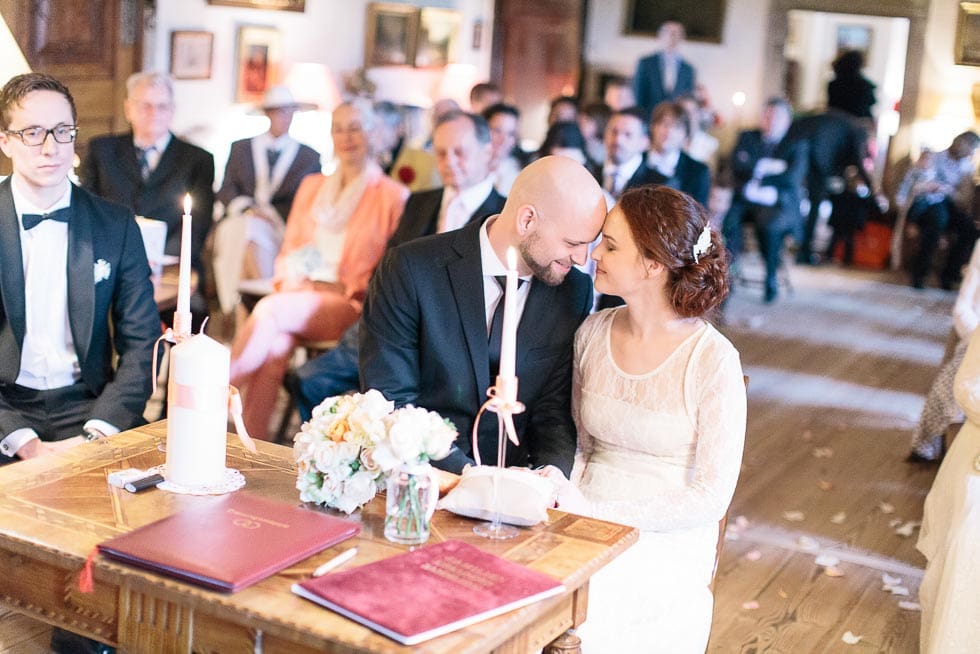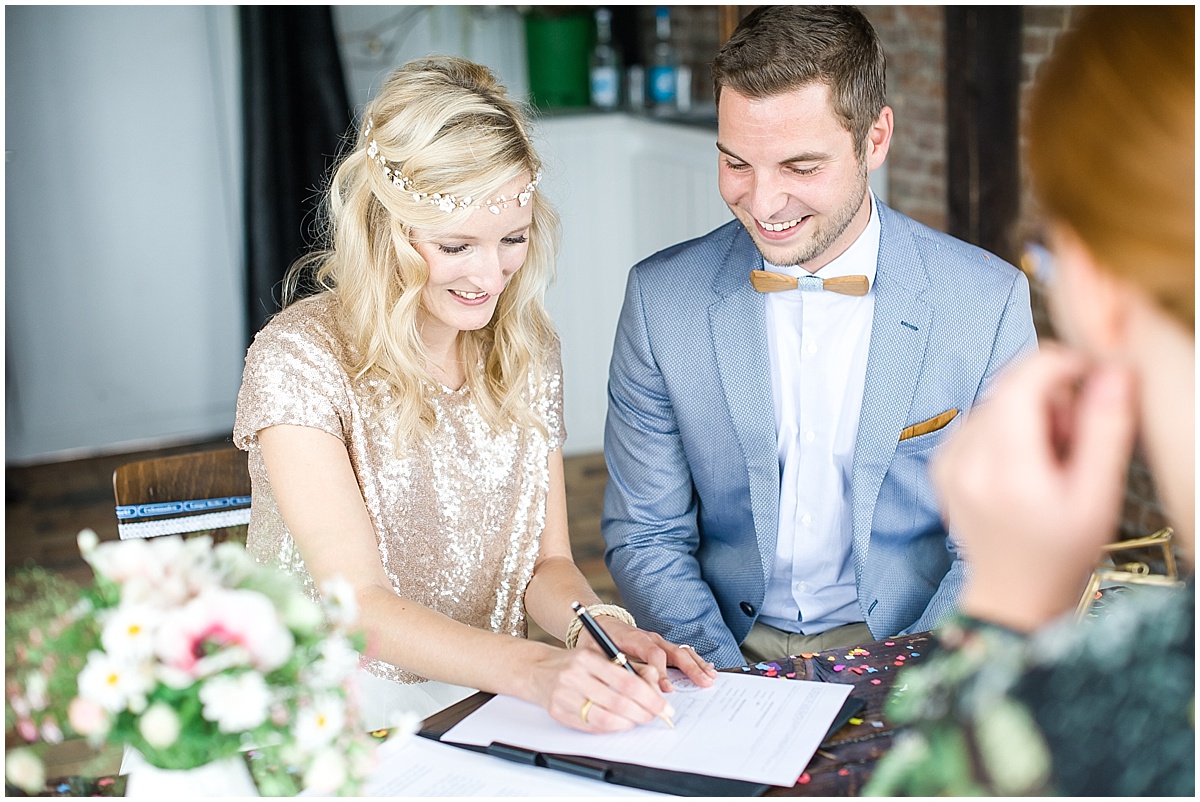In episode 4 of the German remake of Ghosts, they host a wedding. The bride and bride walk down the aisle, pass on either side of a pair of chairs, and sit down for the ceremony. The fact that a single one of them didn’t “walk down the aisle” and be “given away” to someone up front was pointed out as being non-conventional, but nobody mentioned the chairs one way or the other. So is the couple (whatever the mix); sitting for the ceremony a common enough variant to not merit pointing out? Or something odd that didn’t bother hanging a lampshade on?
German here. Having the couple sit is very common in “Standesamt” weddings, i.e. weddings officiated by a public registrar. Church weddings don’t have effect under secular German law, so if you want a marriage that’s valid in the eyes of the government you’ll need that. If you’re religious, you can have a church wedding in the denomination of your choice in addition to the public one. In church weddings, the usual protocol is for the couple to stand in front of the altar.
I can confirm everything @Schnitte said, but just want to add one point: a wedding doesn’t necessarily has to happen at the official registrar’s office (which mostly is in the town hall), but many communities offer weddings at historically or architecturally outstanding buildings or sites. In these cases the registrar comes over to the place and performs the wedding there. For instance, the town next to my home town has an old castle with a so-called knight’s hall where you can arrange a wedding. A cousin of mine and two close friends had their weddings there. I also just yesterday happened to learn that it’s possible to have a wedding on board a cruise ship on a nearby lake.
ETA: as for the actual question: yes, in most non-Church weddings the couple is seated, and I never had a second thought about it until this thread. But I understand that it’s unusual for a place like the USA where civil weddings are not a thing.
That TV episode was the first time I had ever seen or heard of it.
(Oh, and I did do my homework on the topic, but all I could google up was discussion of the seating at wedding receptions.)
Two of my friends (separately), and also my nephew, had what we call “courthouse weddings”, and a reasonable estimate of their frequency here in the US is 1 in 20 or better, though I suspect it’s way more common in urban areas. My friends that did it followed up (in both cases) with a party that didn’t have much of the usual wedding structure.
Did they sit in chairs for the ceremony?
Doubtful.
I got married by a clerk in the Manhattan Municipal Building. We did the paperwork sitting down, but stood for the actual ceremony.
The TV episode didn’t include a table or paperwork.
(I used English subs found elsewhare.)
I just skimmed the episode, and it seems to be a fantasy series, so we don’t have to expect accuracy. Also, the paperwork is the most boring and mundane part of the ceremony, so why should they have showed that?
Yeah, civil weddings are absolutely a thing in the US — I’ve been to a number — whether of the courthouse type or non-religious ceremony type, but in all cases the couple was standing. The only ones I’ve seen seated at a table were Muslim weddings (at the nikkah.)
Jewish weddings traditionally have the signing of the marriage contract, or ketubah, right before the wedding ceremony itself. This usually takes place sitting at a table, but without an audience present.
I think that whether civil weddings are a thing depends on what you mean by civil wedding. If “civil wedding” means two people and a couple of witnesses in a government office and that’s all, that might not be so common. If “civil wedding” includes either a government office ceremony followed at some point by a party/non-binding ceremony combo or a legally binding ceremony conducted by someone who was ordained online , with no training in a religion that has no churches, congregation or services , those are a lot more common.
As far as sitting goes , it’s been a long time since I’ve been to one , but a Catholic nuptial Mass is exactly like any other Mass in terms of sitting , standing, kneeling. They are also over an hour long. Other wedding ceremonies are much shorter and often in a location where the guests won’t have a view if the bride and groom sit.
I frankly don’t know when the paperwork happens in a German civil marriage, I never witnessed one because mostly the rooms aren’t big enough for the whole audience and only close family attends while the rest wait outside. But I suspect that the marrying couple signs the papers just before or after the marriage vow.
That’s basically what I meant. As @Schnitte explained, a civil marriage is obligatory in Germany to be officially acknowledged, so this is what most civil weddings look like. Although a party follows in most cases, but often only after a (optional) religious ceremony.
They are. Usually, you get married at the courthouse (where we got married), city hall, or at a magistrates’s office. It’s also common to have a friend of the couple be the officiant.
Yeah, I misspoke, I should have said obligatory civil weddings.
OK, so when you are talking about the bride and groom sitting at a civil wedding, you’re not talking about the bride and groom sitting for a ceremony taking place in front of all their guests, right? I have no idea if the bride and groom normally sit or stand in the “government office and a couple of witnesses” weddings in the US - I’ve never been to one and I suspect most people haven’t been to more than one or two of those, too few to have an opinion about what’s common. Even people who don’t want an actual religious ceremony often have some sort of ceremony at the reception site , even if they had a courthouse ceremony for legality. They can get a judge or a mayor or other official authorized to perform weddings to perform a legally binding ceremony at the reception site, but that’s going to be based on some sort of personal relationship with the official.
OK, so when you are talking about the bride and groom sitting at a civil wedding, you’re not talking about the bride and groom sitting for a ceremony taking place in front of all their guests, right?
Right, as I mentioned in a post above, most rooms where civil marriages are performed are just too small to hold all the invited guests, so only the witnesses and close family attend. But they all meet again at the party after the ceremony. It used to be common that the civil ceremony was performed in the morning, the religious one in the afternoon and the party in the evening, but today most people either skip the whole religious part or have their religious ceremony on a later separate day.



